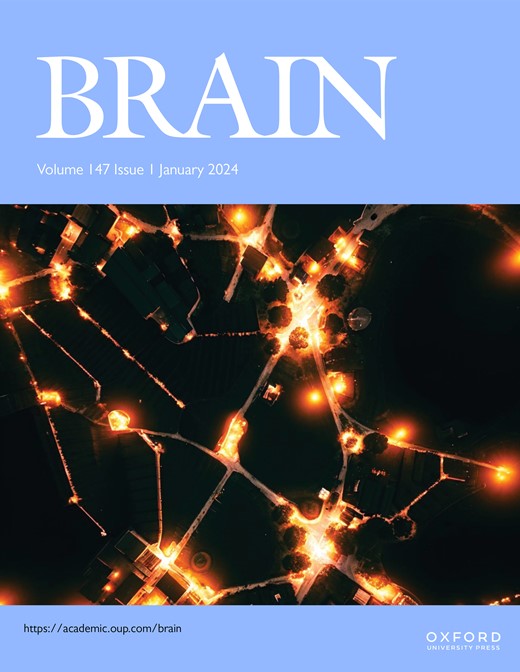社区生活老年人血浆生物标志物特征的神经病理学相关性
IF 11.7
1区 医学
Q1 CLINICAL NEUROLOGY
引用次数: 0
摘要
阿尔茨海默病和阿尔茨海默病相关痴呆(AD/ADRD)的外周液体生物标志物研究迅速增长,因为它们是非侵入性的、相对便宜的、容易获得的。最常用的血浆生物标志物包括β-淀粉样蛋白(Aβ)、磷酸化tau蛋白(p-tau)、神经丝轻链(NfL)和胶质纤维酸性蛋白(GFAP)。多种血浆生物标志物的不同特征与常见神经病变的关联程度尚不清楚。利用405例社区老年人的临床病理资料,我们对Aβ42/40比值、p-tau217、NfL和GFAP等4项血浆生物标志物进行了潜在谱分析,并研究了潜在谱与AD、路易体、边缘显性年龄相关性TDP-43脑病(LATE)、海马硬化症、慢性宏观梗死、微梗死、脑淀粉样血管病等5项血管指标的相关性。动脉粥样硬化和动脉硬化。参与者的平均死亡年龄为89岁,在死亡前3.9年测量血浆生物标志物的血液样本。超过75%是女性,24%是非拉丁裔黑人。我们观察到3种不同的生物标志物谱。特征1,低p-tau217,低GFAP,低NfL和高a - β42/40,代表大多数参与者(55.6%)的生物标志物水平高于平均水平。图谱#2和图谱#3的生物标志物水平都低于平均水平。概况#2,代表34.8%的参与者,p-tau217和GFAP较高。相比之下,概况#3,代表9.6%的参与者,在NfL和GFAP中都很高。对这些血浆生物标志物谱的神经病理学相关检查显示,谱#2是神经退行性疾病负担高的老年人的例证;在资料#2中,几乎所有的参与者(92.9%)都被诊断为病理性阿尔茨海默病,并且该组中路易体的参与者比例也最高(41.1%)。相比之下,概况#3举例说明了患有更严重血管疾病的老年人;这组患者的宏观梗死比例最高(31.6%),中度或重度动脉粥样硬化比例最高(42.1%)。总之,这些发现表明,常见的血浆生物标志物可能表现出反映不同病理生理过程的特征。本文章由计算机程序翻译,如有差异,请以英文原文为准。
Neuropathologic correlates of distinct plasma biomarker profiles in community-living older adults
There has been a rapid growth in research on peripheral fluid biomarkers for Alzheimer’s Disease and Alzheimer’s Disease related dementias (AD/ADRD) because they are non-invasive, relatively inexpensive, and easily accessible. The most commonly used plasma biomarkers include β-amyloid (Aβ), phosphorylated tau (p-tau), neurofilament light chain (NfL), and glial fibrillary acidic protein (GFAP). The extent to which distinct profiles of multiple plasma biomarkers correlate with common neuropathologies is unclear. Using clinicopathologic data from 405 community-dwelling older adults, we applied latent profile analysis on 4 plasma biomarkers, i.e., Aβ42/40 ratio, p-tau217, NfL and GFAP, and examined the correlates of the latent profiles with 4 degeneration measures of AD, Lewy bodies, limbic-predominant age-related TDP-43 encephalopathy (LATE), hippocampal sclerosis, and 5 vascular measures including chronic macroscopic infarcts, microinfarcts, cerebral amyloid angiopathy, atherosclerosis and arteriosclerosis. On average, participants died at the age of 89 and blood samples for plasma biomarkers were measured 3.9 years before death. Over 75% were female and 24% were non-Latino Black. We observed 3 distinct biomarker profiles. Profile #1, characterized by low p-tau217, low GFAP, low NfL and high Aβ42/40, represents most participants (55.6%) with better than average biomarker levels. Both Profile #2 and Profile #3 showed worse than average biomarker levels. Profile #2, representing 34.8% of the participants, was high in p-tau217 and GFAP. By contrast, Profile #3, representing 9.6% of the participants, was high in NfL and GFAP. Examination of neuropathologic correlates of these plasma biomarker profiles revealed that Profile #2 exemplifies older adults with a high burden of neurodegeneration; almost all participants (92.9%) in Profile #2 had a diagnosis of pathologic AD, and the group also had the highest percentage of participants with Lewy bodies (41.1%). In comparison, Profile #3 exemplifies older adults with more severe vascular conditions; participants in this group had the highest percentage of macroscopic infarcts (31.6%) and moderate or severe atherosclerosis (42.1%). Together, these findings suggest that common plasma biomarkers may exhibit profiles reflective of distinct pathophysiologic processes.
求助全文
通过发布文献求助,成功后即可免费获取论文全文。
去求助
来源期刊

Brain
医学-临床神经学
CiteScore
20.30
自引率
4.10%
发文量
458
审稿时长
3-6 weeks
期刊介绍:
Brain, a journal focused on clinical neurology and translational neuroscience, has been publishing landmark papers since 1878. The journal aims to expand its scope by including studies that shed light on disease mechanisms and conducting innovative clinical trials for brain disorders. With a wide range of topics covered, the Editorial Board represents the international readership and diverse coverage of the journal. Accepted articles are promptly posted online, typically within a few weeks of acceptance. As of 2022, Brain holds an impressive impact factor of 14.5, according to the Journal Citation Reports.
 求助内容:
求助内容: 应助结果提醒方式:
应助结果提醒方式:


